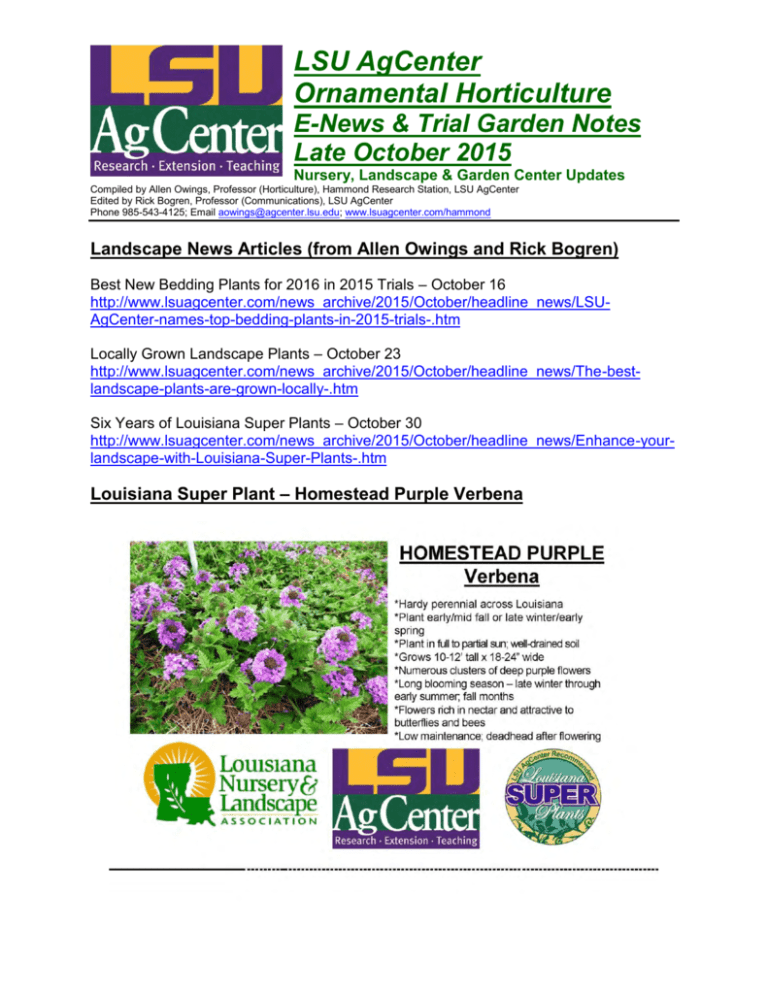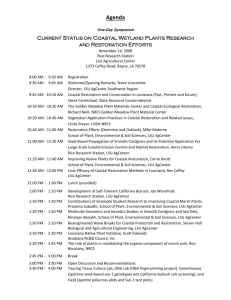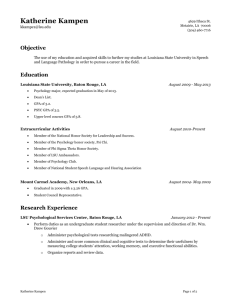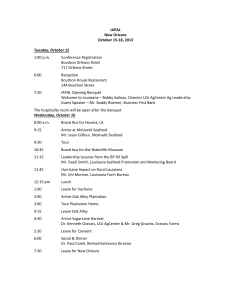LSU AgCenter's - Louisiana Nursery and Landscape Association
advertisement

LSU AgCenter Ornamental Horticulture E-News & Trial Garden Notes Late October 2015 Nursery, Landscape & Garden Center Updates Compiled by Allen Owings, Professor (Horticulture), Hammond Research Station, LSU AgCenter Edited by Rick Bogren, Professor (Communications), LSU AgCenter Phone 985-543-4125; Email aowings@agcenter.lsu.edu; www.lsuagcenter.com/hammond Landscape News Articles (from Allen Owings and Rick Bogren) Best New Bedding Plants for 2016 in 2015 Trials – October 16 http://www.lsuagcenter.com/news_archive/2015/October/headline_news/LSUAgCenter-names-top-bedding-plants-in-2015-trials-.htm Locally Grown Landscape Plants – October 23 http://www.lsuagcenter.com/news_archive/2015/October/headline_news/The-bestlandscape-plants-are-grown-locally-.htm Six Years of Louisiana Super Plants – October 30 http://www.lsuagcenter.com/news_archive/2015/October/headline_news/Enhance-yourlandscape-with-Louisiana-Super-Plants-.htm Louisiana Super Plant – Homestead Purple Verbena Louisiana Super Plant – Leslie Ann Camellia Establishing a new fig orchard at Hammond (from Allen Owings, Charlie Johnson, Jason Stagg and Joey Quebedeaux) Figs (Ficus carica L.) have been an important fruit crop in Louisiana for over 150 years and are one of the most popular small fruit crops grown here. Small orchards supporting local market areas can be found primarily in south Louisiana, but trees are still grown as a residential dooryard fruit crop in every parish. With local farmers markets becoming more prominent in major population areas of the state, there is now more demand for fresh figs for local sales. Fig trees are relatively easy to grow and can easily fit into an organic food production system. About 10-15 varieties of figs are commonly sold in Louisiana, but some individuals and small nurseries have numerous additional varieties. Interest is growing about fig cultivars that perform well in Louisiana – not only those released previously by the LSU AgCenter but also some of the historically important older varieties. Because this interest in figs is creating demand beyond the normal fruit harvesting industry, a new fig research orchard will soon be established at the LSU AgCenter Hammond Research Station. In the 1950s, a fig breeding program was initiated by the LSU AgCenter to develop cultivars for the Gulf South region of the U.S. Although this breeding effort was officially discontinued in the early1960s, elite selections from this program were maintained over the years. Selections from this group were eventually chosen to be released as cultivars because of their superior fruiting characteristics. The releases were named Champagne, LSU Gold, LSU Purple, O’Rourke, Tiger, and Scott’s Black (previously listed as breeding number L55-2-66). These selections are distinct from other available fig cultivars and offer a unique blend of color and size for commercial and residential use. These cultivars enhance the diversity of fruit characteristics offered for sale and produce larger, good quality fruit that can increase demand. The LSU AgCenter has one of the few accurately current “true-to-type” fig variety collections in the multi-state area. The new research orchard at Hammond will serve as an accurate germplasm collection, which will allow industry cooperators to obtain cuttings of desired varieties for 10-20 years into the future. Figs are easily propagated and can be grown to a saleable tree in about 10 months, so this should present a good opportunity for local plant nurseries. Over a 24-30 month period, the orchard will also provide data on initial growth habit and patterns, initial fruiting, ease of propagation, cold damage and disease susceptibility. A revised LSU AgCenter list of recommended fig varieties will be developed (not updated since 2001). The new fig orchard at Hammond will be located on the site of the former grape orchard and will be prepared by establishing 12-to-18-inch raised rows that will be 20 to 22 feet apart. The site will continue to be limed to raise the soil pH to 6.0-6.5. Between 20 and 25 cultivars of figs will eventually be planted in replication in the orchard. Besides the six released LSU cultivars noted above, the station has collected the following varieties that will also be planted: Alma, Celeste, Hardy Chicago, Hunt, Ithaca, Jack Lily, Kadota, Magnolia, Marseilles, Smith, Southeast Brown Turkey and Texas Everbearing. Gulf States Horticultural Expo (January 20-22, 2016) HOLD THE DATE EDUCATIONAL SESSIONS – Wednesday, January 20 TRADE SHOW – Thursday, January 21, and Friday, January 22 Louisiana Super Plants 2016 Native Plant Demonstration and Evaluation (from Yan Chen, Allen Owings, Gina Hebert and Jason Stagg) A native plant is one that occurs naturally in a particular region, ecosystem or habitat without direct or indirect human intervention. For urban and suburban environments, native plants help minimize negative impact of human dwelling by improving overall continuity of natural habitats for insects, birds and other wildlife. For consumers, landscape designs incorporated with native plants provide a sense of place, an experience with local flora and fauna, and most importantly, less reliance on fertilizer, pesticides and water if the native plants are planted with preferred site conditions. At the Hammond Research Station, many native plants can be found in the Penny woods, Mrs. Margie’s Azalea Garden and the urban forestry area. Since 2014, a new native plant demonstration and evaluation area was developed in the Care & Maintenance area featuring native grass, forbs and small shrubs. Plantings were designed to have increasing amounts of native plants as design components and demonstrate completely non-native plants, natives as companion plants to non-natives, and designs that use native plants only. Plant growth and maintenance requirements are being recorded and compared among designs, and overall plot aesthetic appearance and consumer preference will be assessed by gardeners with different gardening experience levels (Photo 1). For native grass, efforts have been made to demonstrate locally collected species that (1) provide seasonal interests in the gardens with leaf/inflorescence color, shape and texture, or (2) are excellent candidates for manipulation to produce dwarf and turf-type plantings for non-mown areas or areas requiring minimum mowing. Grasses selected for these purposes will be further evaluated for planting time, growth and maintenance requirements, and container production requirements. Native grasses that can be viewed in the plots include: Indiangrass, Sorghastrum nutans (L.) Nash Little bluestem, Schizachyrium scoparium (Michx) Nash Narrow-leaf bluestem, Schizachyrium tenerum Purple-top, Tridens favus L. Purple lovegrass, Eragrostis spectabilis (Pursh) Steud. Sideoats gramma grass, Bouteloua hirsuta Split-beard bluestem, Andropogon. ternarius Michx Switch grass, Panicum virgatum L. Native forbs: Rudbeckia nidita, R. grandiflora, R. maxima, R. subtomentosa Liatris elegans, rain lilies (Zephyranthes spp. and hybrids), several milkweeds, etc. Native shrubs that will be available in designed plots include: Eastern sweetshrub, Calycanthus floridus L. Sweet pepperbush, Clethra alnifolia L. Swamp titi, Cyrilla racemiflora L. Strawberry bush, Euonymus americanus L. Gall berry (inkberry), Ilex glabra (L.) A. Gray Dwarf southern waxmyrtle, Morella cerifera (L.) Small Common hoptree, Ptelea trifoliate L. Elliott’s blueberry, Vaccinium elliotii Swamp-haw, Vaccinium nudum Sparkleberry, Vaccinium arboretum Why locally collected natives? Local herbivores, including native insects and birds, fish and toads that are essential in the food chain, often cannot recognize non-native plants as food. Not all cultivated native plants can serve the local food chain the same as natives and may even have negative effects, i.e., interbreed and weaken local genotypes. Production of narrow-leaf bluestem (front) and split-beard bluestem from seeds to 6inch size plants in a research greenhouse at the Hammond Research Station Native plant demonstration plots at the Hammond Research Station Care & Maintenance Area, featuring little bluestem, rudbeckia and indiangrass planted with Double Knock Out roses. LSU AgCenter Plant Diagnostic Clinic LSU AgCenter Soil Testing and Plant Analysis Lab






